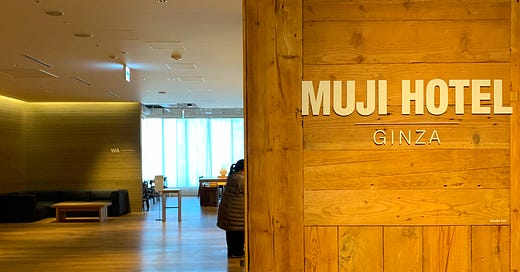From Social Affordance to Lifestyle
Letter from Japan: Why Muji beats Louis Vuitton in the lifestyle game
On a Friday afternoon in Osaka, I stopped by the new Louis Vuitton flagship. Much talk has been made of LVMH’s foray into hospitality, and of the Louis Vuitton’s first-ever cafe and a restaurant in particular. I was intrigued.
And indeed, the building is distinctive enough. It features a facade made out to look like the sails of a the traditional Japanese Higaki-Kaisen cargo ship, a nod to Osaka’s naval history. But take the elevator to the 7th floor to Le Café V, and you’ll find yourself in much less impressive setting. The space is stuffy and suffers from the conflicting aesthetics and a very 80’s vibe (and not in a good way). The terrace has no view but a lot of Tiffany blue chairs. I completely missed the artwork by Tracey Emin despite (or maybe because) it was placed right in front of the elevator. The crowd is mostly clad in LV garb and wasn’t particularly sophisticated. Tourists mingle with provincial businessmen. Most people seemed to be there so they can take an Insta (myself included).
All of this seems to be exactly the purpose of this establishment, and of many more to come per LVMH’s ambitions. One doesn’t go to a Louis Vuitton restaurant for the food or cocktails; they go there to show and tell.
It’s great to claim that this is all in the name of the brand projecting a lifestyle, but let’s call spade a spade: taking a photo in LV cafe signals status in the same way that a LV bag does. Louis Vuitton having a restaurant just confirms what LV already is: a traditional status-signaling, high-end fashion brand. It’s not a reflection of one’s lifestyle, but of their social affordance.
In the modern aspiration economy, social affordance is accrued in the same way that material goods are, but in the social domain: a significant social following, a carefully curated online persona, a witty social copy, meticulously composed Instagrams or as many Insta stories from global locations/events/experiences as possible.
Both lifestyle and social affordances reflect a shift in spending patterns from tangible goods to intangible service and experiences, and this makes it easy to confuse them. Modern brand strategy is to blame: in the flattened modern aspiration landscape, where retail, hospitality, media and entertainment, experiences and service are all mixed together, proclaiming a company to be a standard-bearer of a lifestyle is seen both as a competitive advantage and a wider reason for its being.
Categories from cooking to drinks to activewear to grooming to interior design all offer great social affordances in the modern aspiration economy, but few manage to reach the level of a lifestyle.
Choose one of the paid subscription options to access the rest of this analysis, including a selection of strategies for turning your brand into a lifestyle.
Keep reading with a 7-day free trial
Subscribe to The Sociology of Business to keep reading this post and get 7 days of free access to the full post archives.




